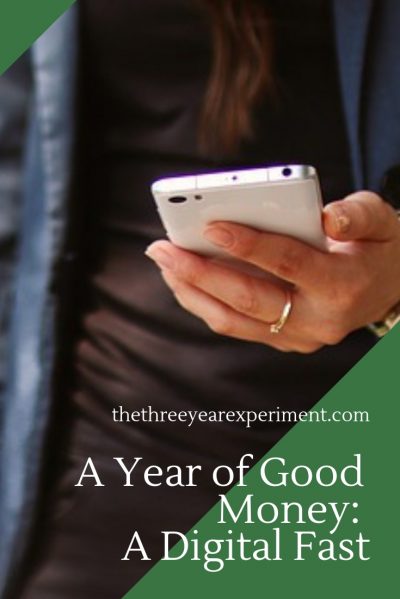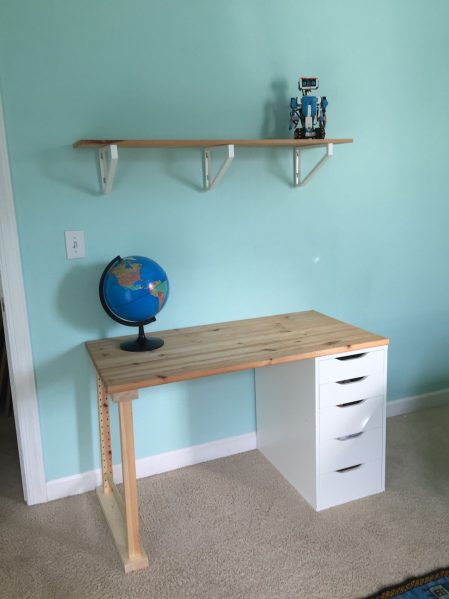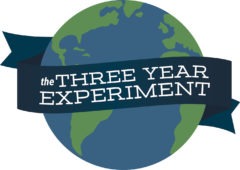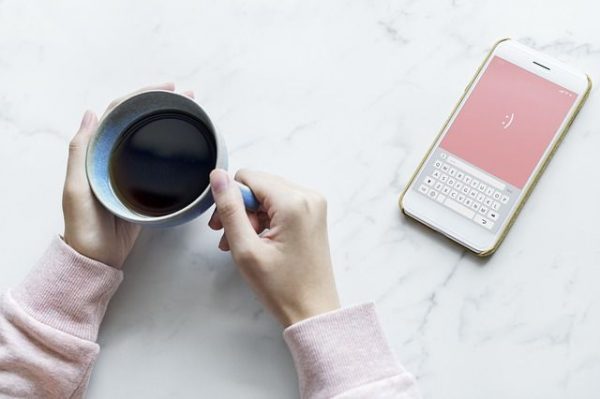What does a digital fast have to do with getting better at money? I think it might be quite a lot, actually.
This year, my family is focusing on making better spending decisions. To that end, we’re (I’m) engaging in twelve eleven (I forgot in March) money experiments designed to help us reexamine our spending patterns and hopefully, get better at them. I’m calling this A Year of Good Money.
In February, I took on a no-spending challenge, my Frugal February challenge, and we spent less than we had in a year. The crazy part was, I was the only one in my family engaged in the challenge. I set rules for myself, which were that I would spend nothing outside of groceries, gas, and bills, but I wouldn’t involve my family members in the challenge, since Mr. ThreeYear was traveling a lot and I didn’t want to make things harder on him, and I didn’t want to stop the boys from their activities.
I think the experiment showed me how programmed I am to spend money. Sadly, in March, I went back to my old ways, and spent more than ever, as some commenters predicted. To be completely effective, it’s clear that I’ll need to engage in a no-spend period that’s longer than a month, because I did delay spending for a month, rather than stop spending in a certain category at all. Here are all of my thoughts on what I learned during the month.

April’s Experiment
I ordered Cal Newport’s new book, Digital Minimalism (that’s an affiliate link) from the library and it came in last weekend. I began to read, and was instantly reminded why I love Cal Newport’s work so much.
Two summers ago, I watched his Ted talk and read Deep Work, and I really responded to his thoughts on how much of social media was superfluous, adding perhaps marginal value for its users but also creating uncounted drain on our lives and a pesky low-grade addiction to our phones.
I wrote about it here.
I’ve noticed, since we moved to North Carolina and I haven’t been working, that I’ve spent unnecessary time on my phone.
I still use Twitter and Facebook at reasonable levels, but Instagram had become my de-facto time-waster.
The worst part about Instagram is, it leaves me feeling bad. I’m terrible about comparing myself to other Instagrammers and not feeling like I’m accomplishing enough for my house, finances, or blog (and ironically, those goals can’t be accomplished simultaneously, so there’s absolutely no way to win that comparison game).
An early paragraph in Newport’s book stuck out at me:
“Addiction is a condition in which a person engages in use of a substance or in a behavior for which the rewarding effects provide a compelling incentive to repeatedly pursue the behavior despite detrimental consequences.
Wow. “continue to use even with negative results.” It reminded me a lot of my wake-up call with drinking. Why would I continue to engage in a behavior that leaves me feeling bad afterwards, even if I had a rush or two of good feelings at the beginning?
I shouldn’t!
Newport does make the distinction that the addictions we have to checking our phone aren’t the same kind of chemical addictions people develop with drugs and alcohol. Our phone addictions tend to be low-grade addictions that, while not causing physical withdrawal symptoms, do become behavioral addictions that change the way we behave, especially during little periods of free time in our day–waiting in line, sitting on the couch, in the bathroom (you know you check your phone on the toilet).
A Digital Fast is a way to break yourself of that low-grade addiction, and replace your obsessive phone-checking with quality leisure activities that provide real connection and satisfaction.
Digital Fast
Newport’s idea is simple: write some rules for yourself for how you will engage with digital media for the next thirty days. You should step away from all non-necessary digital consumption and you’ll need to give yourself rules for how, why, and when you do use the internet.
During the thirty days’ fast, actively cultivate activities that enrich your life and can replace your mindless scrolling. These can be hobbies, leisure pursuits, or new goals that improve your life.

After the thirty days, you’ll want to carefully examine each social media or digital tool you’ve used in the past, and only reintroduce that tool if you determine that it brings you incredible value.
My Rules
Here are my rules for my thirty-six day digital fast (I started on March 24th):
- No Instagram, Facebook, or Twitter at all during the fast. I removed the apps from my phone. The only exception is that I have an auto-post feature on my blog when I publish a new post, so those posts will publish, but I will not actively visit the sites.
- No checking email on my phone. I removed the app from my phone, and I cannot go to the internet to check my email (I had to add this rule after the first three days because I found myself doing this, and I determined it wasn’t absolutely necessary).
- No Kindle books. I should only read hardback books I check out from the library. The reason for this is that I often check out internet books obsessively, and they are more often than not junk books. This type of reading is more like an addiction and does not bring value to my life; in fact, it decreases my presence for my family.
- I can use the internet at my desk upstairs in my office to write blog posts, check email, and read blog posts. I tend to do this in a more limited way and it’s very deliberate, since I have to climb the stairs to get to my computer, so I feel like this is an appropriate use of the internet.
- When appropriate, leave my phone at my desk so that it’s not by my side all day.
I have been at the fast for a little over a week, and here are my initial thoughts:
What’s Been Easy
First, some parts of the fast have been easier than I thought. I haven’t missed Facebook, Twitter, or Instagram at all, except for the few times that I’ve thought, “I should take a picture of that and put it on Instagram.” Instead of doing that, I’ve either a) not taken a picture, or b) taken a picture and sent a text to my family or friends, sharing the moment.
Newport makes the point that we’ve replaced real conversation with people with the approximation of conversation, which he calls connection (I don’t agree with his choice of word). He asks if we really need to keep up with old high school friends we haven’t seen in twenty years on Facebook? Because when we do, we’re not actually connecting with him (see why I don’t like his word?). Instead, we’re making the approximation of a connection, in liking or commenting on a post. Wouldn’t our relationships (and life) be richer if we skipped such low-grade connections and instead, reached for the phone or made plans to meet up IRL (in real life) with friends?
When I’ve felt the urge to connect with someone, I’ve done it. I texted a friend and made plans to get our families together this August. I’ve picked up the phone and called my mom, sister, or a friend. So far, it’s worked pretty well.

What’s Been Hard
Second, some parts have been harder than I thought. Saturday morning was hard. Turns out, I normally get up and scroll through my phone for a couple of hours! I realized this because last Saturday morning, I felt that urge for a couple of hours. Instead, I cleaned the kitchen, made banana bread muffins, called a friend, talked to my family, and worked in the garden. That definitely taught me a lot.
Last night, Sunday night, I found myself scrolling through Apple News, which I haven’t explicitly excluded from my fast (but I’ll probably need to). I was tired after a busy weekend, and didn’t want to read any of the books I had. I just wanted some mindless reading. However, reading the (frankly) horrible selection of news articles available didn’t make me feel better. So, that’s an area I’ll need to explore more in terms of replacing one behavior with another.
Mental Clarity (Maybe?)
Third, and this has been an unexpected benefit, I can already tell that my brain is clearer, even after a week. It might be another effect at work, like Spring or the sun, but I’m finding myself making connections that I previously wouldn’t have made. In other words, through the articles I am reading, which tend to be carefully selected, I’m synthesizing ideas a little better than I was before.
I’ve always suspected I’m a bit more susceptible to digital noise than the average person, which is one of the reasons I’m such a fan of simplicity, so I’m interested to see what a month of digital detox will do.
I’m hopeful that more mental clarity will help me make better spending decisions, and that defining a Digital Minimalist Philosophy will help me better spend my time on high-value activities that I’ve thoughtfully cultivated, rather than low-value time-suckers. We shall see.
If you’re interested in learning more about a Digital Detox, see if your library has a copy of Cal Newport’s book, Digital Minimalism.
Have you ever done a Digital Detox? If so, I’d love to hear how it went–the good and the bad–in the comments.



What a great, and ambitious idea! I feel like we would all have so much more time if we broke off from technology. I’m curious to hear how this all goes at the end of the month. From a blogging perspective, do you worry at all about not being able to promote your posts on Twitter and Facebook more than the original automatic send out? Great post!
Dave, thanks. Yes, maybe even overly ambitious, especially when it comes to blogging. 🙂 I’ve worried about losing traction with my blog, but so far, my traffic seems to be pretty consistent. I think I’ll know more after the month is over. I’m really hoping for some clarity when it comes to Instagram and Twitter, because even though they bring in traffic for me, they really can be huge time sucks and I don’t particularly love Twitter. Time will tell!
i don’t have the phone problem being sans phone but having down time at work gives me ample opportunity to waste time there. i have that saturday morning issue, though, with the laptop. i finish reading and checking what i want to check within an hour but the computer is there out of boredom. we can all do better i guess. we miss our friends in real life and this past xmas we had a free day and drove to boston (3 hours) just for dinner and an overnight and drove back to the in-laws the next day. it was out of the way but totally worth it.
Yeah!! I am glad to read about someone else who reads Cal Newport. I also put the digital fast into practice a couple of months ago and found it so refreshing. No Facebook posting or scrolling, no Instagram… Instagram was tough to kick for me too but I started asking myself “what is my intention? Who do I want to share this moment with?” when I started feeling the urge to post a random-moment photo. I even opened up “conversation office hours” which allowed me to reconnect with friends I don’t catch up with often. I’ve let up on the fast now, but I find I spend a lot less time absorbed in those tools and I don’t enjoy it beyond about the first two minutes anyway. I’m much more present in my daily life.
I love the “conversation office hours” idea! I’ve thought about going to a local coffee shop at a set time for that. Very glad to hear that you’ve continued not to let social media take over after the fast. I think replacing your habits with something better is the key.